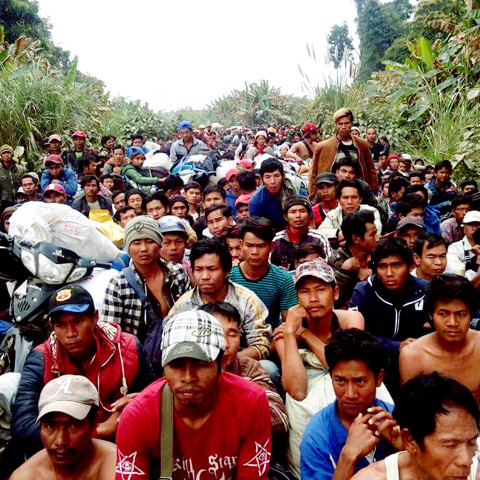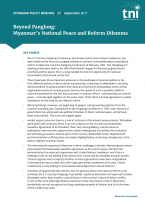Multiculturalism and Social Justice in the Modern Nation-State A Myanmar Commentary
An ethnocratic state produces a form of fascism in which the state supports the rights and welfare of the dominant ethnic group, but not others. By contrast, a tolerant multicultural state or plural society permits all people, regardless of ethnicity, to be recognised as equal members and thus achieves social justice. This comparison suggests that narrow nationalism is a chief source of the failure of Myanmar to become a modern and successful nation-state.

Hugawng Salum
Framed in the Myanmar context, does the ruling elite maintain the mind-set of those during the ancient Alaungpaya empire? From this perspective, non-Bamar nationalities served as their subordinates. This period in politics dates back to the 15th and 16th centuries, when the nation-state first emerged in Europe as a system of centralized rule that succeeded in subordinating all other institutions and groups, both temporal and spiritual. Since this time, the continuing practice of the ethnocratic state in terms of social justice has led at times to the absolute neglect of minority peoples and cultures, feeding resentment and rejection of the central government on the part of marginalized ethnic groups and fuelling conflict that has, in turn, produced grave human rights’ abuses and furthered alienation.
Domination in culture and politics by one nationality group, however, is not an inevitable consequence of modern nation-state formation. The emergence of the nation-state is often connected to the terms of the Peace of Westphalia (1648), which weakened the theocratic rule of the Holy Roman Empire, guaranteed a large measure of religious tolerance and gave local princes, particularly in Germany, more sovereignty over their territories. The provisions for religious tolerance included allowing private worship, liberty of conscience and the right of emigration to all religious minorities and dissidents within their domains.
In Myanmar today, within the general picture of ethnic marginalization, the case of Rohingyas is admittedly especially complicated and relates to a legacy of British colonialism. However, an important point is that the current discourse in national politics is characterised by a glaring lack of compassion. In addressing this omission, social justice has a vital role to play. Social justice is a concept of structural compassion that can address the marginalized of society or underdogs by creating a safety net. It is also importantly different from legal justice. The latter concerns fairness in terms of the behaviour of a group or individual from a legal perspective. By contrast, social justice perspectives are broader and look at the arrangement of social structures which ensure that wealth, power and recognition are fairly distributed in society.
The enjoyment of social justice is essential in Myanmar today. Social justice informs perspectives on fairness that address questions about the implications of the types of markets in society, such as whether they are free markets, social markets or a state-controlled market. What are the implications of approaches to taxation and governance on people’s social welfare? Such issues, in turn, raise questions about the level of concentration of power at the state centre and its decentralization. For instance, how much decision-making authority should be shared by regional and local level bodies? These issues also move beyond core issues of governance to look at the media from the perspective of whether it should be private or public. Who controls the education system? Is it private, public, free for all and what are the costs? What kinds of healthcare system are there – for example, public, private or mixed? And how large a gap is acceptable between the “haves” and the “have-nots” in society?
In daily life, social justice frequently concerns issues that go beyond the government. When the trust of citizens in their legal justice system is eroded, one response is to take the law into their own hands and claim it to be social justice. The “Pat Jasan” movement in Kachin State is a recent case in point. It reflects a popular concern among many Kachins about the lack of trust in the Myanmar government to address the social issues associated with drug abuse. Familiarity with the situation in Myitkyina and Putao, for example, would produce a better understanding of community concerns about the illicit cultivation of opium poppy and the growing epidemic of drug use among young people – as well as increased addiction to heroin and the related spread of HIV and Hepatitis B and C.
Ultimately, in a representative democracy, resolution of these challenges should be the responsibility of a national government in ensuring social justice for all. In the interim, local civil society – including faith-based organisations – can and should draw on appropriate traditional practices, working to attain justice for all members of society. This is particularly important in view of the fact that, in the modern world, social mobility is spreading and villages, towns and cities increasingly include people of various ethnic and religious backgrounds.
In some ways, the Pat Jasan movement in Myanmar is a community response arising out of a frustration with a very difficult drug addiction problem that does not appear to have immediate or straightforward solutions. However, violence towards opium producers and drug addicts is not an appropriate response and only creates more social problems. In a compassionate society, the concept of social justice also needs to be applied to all in a scourge that has complex social roots.
Pat Jasan leaders therefore have to act with fairness, adhering to proper legal procedures. They should consider setting up their own courts and appoint judges who are respectable and accepted by the public, for example. In fact, this practice is nothing new to us as it is in keeping with the Kachin tradition of socially-accepted justice, outside of formal court systems, that has been used for many decades to solve disputes. In addition, building upon experience, community leaders should learn how to resolve conflicts through civil mediators so that people have less need to go to the police and to court. This is part of recreating a just society and earning legitimacy as a governing body. We need to take advantage of every avenue to strengthen the justice system in our society today.
Another important issue is the utter, and continued, lack of social and health outreach by the central state to the remote borderlands and ethnic states by successive governments since independence in 1948. Only a year ago, in August 2016, sixty children experienced an untimely death in the Naga area of north Myanmar. Throughout the developing world, children die because they are born in the wrong place – not because of exotic or incurable diseases. Instead, this suffering comes from commonplace childhood illnesses for which treatments have been available for over a century. In the continued absence of a government capable of delivering routine maternal and child health care to all peoples, children will continue to die in our country.
As a result of experiences like these, many of us feel that the Myanmar state in general – regardless of the ruling party – has long lacked concern for the broader population and considers many people insignificant. If, however, we had equal power, rights and resources, then our people would get better education, health and other skills to improve the quality of our lives as human beings.
All of these issues draw attention to the critical importance of good governance in our country. Such reform is vital as discussions continue about how to end the long-standing divisions and conflicts in our country. Much of the political focus is about the interests and authority of powerful institutions and stakeholders, but an essential – and very under-examined – issue is the role of “we the people”. Presently, there is little social justice. In Myanmar society, most people have lived their lives until now as citizens who have the “right” to pay arbitrary taxes, the “right” to have their labour conscripted into the projects of military governments, the “right” to struggle to provide for their family’s education and health, and the “right” to be silenced.
Equally concerning, many headlines in Myanmar these days are about “Return”. It has to be asked: return for what? Return under what conditions and for whom? It is the same for Kachin, Karen, Shan and other peoples as much as the displaced communities in Rakhine State. The key need confronting us all is return to “our homeland” where everyone can live with dignity and peace. The challenge remains to make the Union of Myanmar the home of all its citizens and peoples. Isn’t dignified return at the very heart of social justice? Certainly, dignified return is not just an internationally-defined norm.
Against this challenging backdrop, enjoying or learning a different set of rights does not happen overnight. But, if peace and reform are to come to Myanmar, progress in political rights and social justice has long been vital. Societal momentum is increasing. Here we are already talking about asking the government to allocate more in national health budgets. The next step is to ask for the different states and regions to have their own budgets to allocate and manage. By this “cultural” shift, we are transitioning from passive to active citizenship, which is an absolute prerequisite for democratization and peace. In such a multicultural and conflict-divided country as Myanmar, the long-standing “top-down” approaches by narrow elites have long failed. The challenge now is the spread of social justice in building peace and national reform, with community and “bottom-up” practices that truly include all peoples.
Lahpai Seng Raw is a 2013 Ramon Magsaysay Award winner and co-founder of the Metta Development Foundation and Airavati. She was also a delegate at the 21st Century Panglong Conferences in 2016 and 2017.
A Burmese language version of this commentary appeared in the latest issue of the Myanmar Quarterly, Vol.1, No.4, January-February 2018.
This commentary is part of a TNI project funded by Sweden. Opinions expressed by the author are not necessarily the views of the donor.



